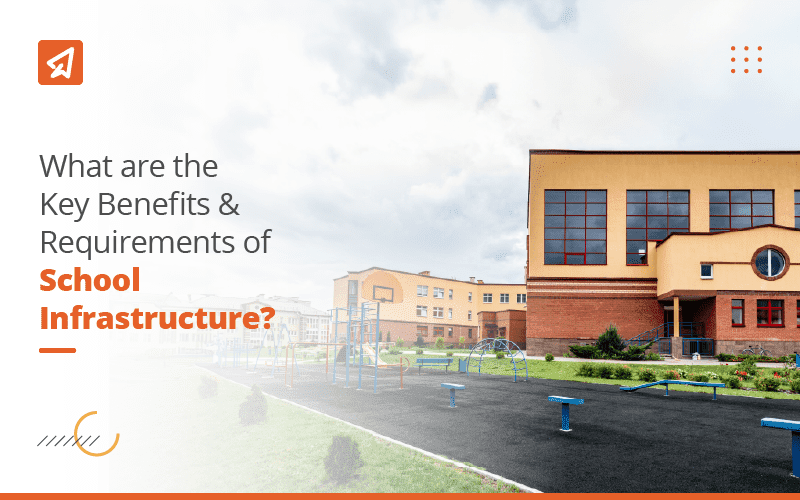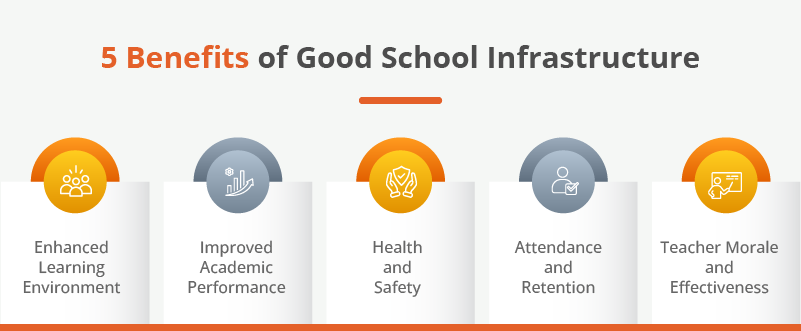What are the Key Benefits & Requirements of Good School Infrastructure?

In the bustling landscape of India’s education system, the state of school infrastructure has emerged as a critical determinant of students’ learning outcomes and overall well-being. With over 250 million students enrolled in K-12 schools across the country, the scale of the challenge becomes evident.
The significance of adequate school infrastructure extends far beyond bricks and mortar; it profoundly influences a student’s educational journey. A well-designed and properly equipped learning environment fosters a sense of security, comfort, and motivation among students. It plays a pivotal role in ensuring their physical and mental well-being, promoting regular attendance, and facilitating effective teaching and learning. Quality infrastructure can enhance the overall educational experience, creating an atmosphere where students can fully engage with their studies and explore their potential.
In essence, good school infrastructure is the foundation upon which a robust and equitable education system is built, impacting not only academic achievement but also shaping the holistic development of the next generation.
5 Benefits of Good School Infrastructure

In this section, we will explore five key benefits that underscore the importance of having well-designed and well-maintained school infrastructure. These advantages extend beyond the physical aspects of a school and have a profound impact on both students and educators, creating a conducive environment for learning and growth.
- Enhanced Learning Environment: Good school infrastructure provides a conducive and comfortable environment for students. Well-ventilated classrooms, modern teaching aids, and well-maintained facilities create a positive atmosphere that encourages active learning and engagement.
- Improved Academic Performance: A well-equipped school with proper resources, such as libraries, laboratories, and computer rooms, can significantly improve students’ academic performance. Access to these resources enables hands-on learning and research, contributing to better educational outcomes.
- Health and Safety: Adequate school infrastructure ensures the health and safety of students and staff. Properly maintained buildings, clean water supply, and sanitation facilities reduce the risk of illnesses and accidents, promoting overall well-being.
- Attendance and Retention: Schools with good infrastructure tend to have higher attendance rates and lower dropout rates. When students have access to clean, safe, and comfortable learning environments, they are more likely to attend regularly and stay in school, leading to higher educational attainment.
- Teacher Morale and Effectiveness: Quality infrastructure not only benefits students but also boosts teacher morale and effectiveness. Teachers can deliver lessons more effectively in well-equipped classrooms, and access to resources helps them develop creative and engaging teaching methods, ultimately benefiting their students.
Investing in and maintaining good school infrastructure is essential for providing quality education and ensuring the well-being of students and educators alike.

School Infrastructure Checklist: Taking a Look at the Key Requirements
- Location: Where a school is located matters a lot for accessibility. It should be easy for nearby students and those who travel from a distance. The location affects daily travel, safety, and overall accessibility for students, teachers, and staff. Ideally, it should be in a safe, calm area that’s good for learning and still connected to the community.
- Size: The school should be big enough for all the students it has now and have room to grow in the future. This means having enough space for classrooms, offices, and places for fun activities. Having enough space is really important so the school doesn’t get too crowded, which could make it hard for students to learn and feel good.
- Class Size and Space: It’s important to have the right number of students in a class for good learning. Smaller classes mean more attention for each student and better talking between students and teachers. Having enough space for each student makes the learning place less stressful and better for learning.
- Building Design and Rooms: Schools should be designed in a way that helps learning. This means having flexible classrooms or smart classrooms, special rooms for arts and science, and areas where students can hang out together. The way the building looks and works should match what the school believes about education and how they teach.
- Equipment: Schools need the right tools for teaching and enjoyable activities. This involves having modern teaching aids, laboratory equipment, sports gear, and good IT infrastructure. Properly storing and maintaining this equipment is crucial for its durability and effectiveness.
- Technology: Nowadays, having good technology is super important. This means fast internet, digital tools for learning, and computer labs. The goal is to use technology to make learning more fun and get students ready for a world filled with technology.
- Interior Space Design: How a school looks inside is crucial for learning. It should be nice to look at and help students learn better. This involves picking the right colors, good lighting, sound quality, and furniture that matches the students’ age. The spaces should be able to change to fit different ways of teaching and how students like to learn.
- Legal Requirements: Following the rules is a must. Schools have to meet certain standards set by the law. This includes things like building codes, safety rules, and making sure everyone can access the school easily. Schools need to make sure they meet all these rules to create a safe and legal place for learning.
- Safety, Comfort, and Security: Having a safe and secure place is really important. This means making sure entrances are safe, having plans for emergencies, and following health and safety rules. It’s also important to have comfortable classrooms with good air, heating, and comfy furniture. All of these things are key for students to learn well and feel good.

Closing Thoughts
So, there you have it – the lowdown on what makes a school an awesome place. From a killer location to comfy classrooms and cool tech, it’s all about creating a space where students can’t wait to dive into their studies. Because hey, a great school isn’t just about classes – it’s about building a second home that feels just right.
Last Updated on February 13, 2025
Reviewed by

Priya Kapoor | AVP - Academics
Priya Kapoor is an accomplished education professional with over 18 years of experience across diverse fields, including eLearning, digital and print publishing, instructional design, and content strategy. As the AVP – Academics at Extramarks, she leads academic teams in creating tailored educational solutions, ensuring alignment with varied curricula across national and international platforms...read more.










